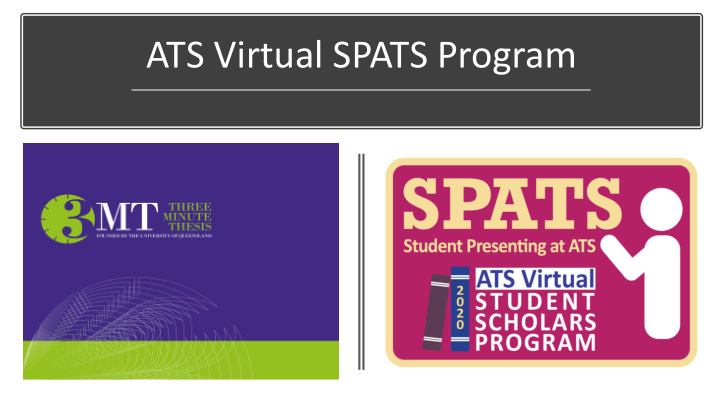



ATS Virtual SPATS Program
Rules • A single static PowerPoint slide is permitted (no slide transitions, animations or 'movement' of any description, the slide is to be presented from the beginning of the oration). • No additional electronic media (e.g. sound and video files) are permitted. • No additional props (e.g. costumes, musical instruments, laboratory equipment) are permitted. • Presentations are limited to 3 minutes maximum, and presenters will have points deducted if they exceed the 3 minutes • Presentations are to be spoken word (e.g. no poems, raps or songs). • Presentations are to commence from the stage (e.g. no walking through the audience). • Presentations are considered to have commenced when a presenter starts her/his presentation through movement or speech. • The decision of the adjudicating panel is final.
Judging Criteria Comprehension & Content • Did the presentation provide an understanding of the background to the research question being addressed and its significance? • Did the presentation clearly describe the key results of the research including conclusions and outcomes? • Did the presentation follow a clear and logical sequence? • Was the thesis topic, key results, and research significance and outcomes communicated in language appropriate to a non-specialist audience? • Did the speaker avoid scientific jargon, explain terminology, and provide adequate background information to illustrate points? • Did the presenter spend adequate time on each element of their presentation -or did they elaborate for too long on one aspect or was the presentation rushed?
Judging Criteria Engagement & Communication • Did the oration make the audience want to know more? • Was the presenter careful not to trivialise or overly generalise their research? • Did the presenter convey enthusiasm for their research? • Did the presenter capture and maintain the audience's attention? • Did the speaker have sufficient vocal range, maintain a steady pace, and have a confident stance? • Did the PowerPoint slide enhance the presentation -was it clear, legible, and concise?
Today, August 4 SPATS Presenters: 7-830PM EST: 1. Daniel Mai 2. Nicole Robertson 3. Sophia Levan 4. Diego Alexei Tovar Giombini 5. Kermit Zhang 6. Niyati Borkar 7. Brett Curtis 8. Nicole Buchely
Interaction Between AP-1 and SWI/SNF Under Disturbed Flow May Promote Vascular Inflammation Daniel Mai, BA, Jan-RenienMoonen, PhD, Marlene Rabinovitch, MD Working Model Proximity Ligation Assay
Knowledge is Power
Poopology 101: Using baby poop to predict childhood allergies and asthma 12, 13 DiHOME Low Risk High Risk
Argument For Sleep: The Intensive Care Unit’s Hidden Killer Agitation Pain Delirium
Its all about the kiss – Gender and Asthma Asthma: Gender Statistics Kiss peptins: A New targeted therapy for Asthma
Goldilocks and O 2 in the ICU “Just Right” O 2 Approach ICU Existing standards of care Hypoxia Free Individuals radicals Aversion to lower O 2 saturations Implementation Concern for patient safety Interprofessional education Belief that too much O 2 lacks harm Buy-in from the entire care team Outcome Desire for supporting evidence “Just Right” Too High O 2 TOO Lung TOO JUST O 2 Saturations Saturations Death MUCH damage LITTLE RIGHT O 2
Recommend
More recommend